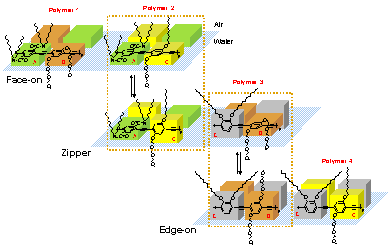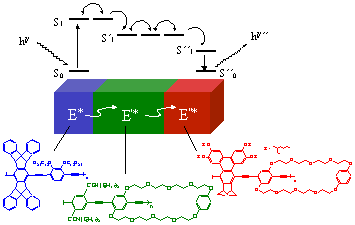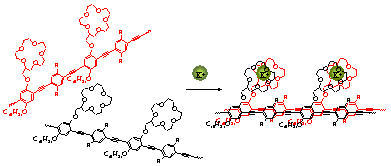Ph.D. Thesis
Title Supramolecular Assemblies of Conjugated
Sensory Polymers and the Optimization of Transport Properties
Adviser Prof. Timothy M. Swager, Department of Chemistry,
Massachusetts Institute of Technology
Thesis Committee Prof. C.A. Ross, Prof. M.F. Rubner (co-adviser),
Prof. E.L. Thomas, Department of Materials Science and Engineering,
Massachusetts Institute of Technology.
Essay
Conjugated polymers (CPs) have become emerging materials
for electronic applications due to the tunability of their properties
through variation of chemical structure. Their applications, which
currently include LEDs, FETs, plastic lasers, batteries, and sensors,
are expanding to many novel areas. The two critical parameters that
determine the function of CP-based devices are chemical structure
and nano-structure of a polymer in the solid-state. While the physical
properties of isolated polymers are decided by their chemical structure,
these properties are altered in the solid-state due to electronic
coupling between polymer chains determined by their interpolymer packing.
However, in more than 20 years of CPs research, the development of
effective precise methods for controlling the nano-structure of polymers
in the solid-state has been limited because polymers often refuse
to assembly into organized structures due to their amorphous character
and large molecular weight.
My Ph.D. research has focused on understanding and optimizing
energy transport properties of CP thin films by achieving supramolecular
assemblies, with the ultimate goal to fabricate high performance solid-state
fluorescence chemosensors. A good sensor must satisfy two key properties
- selectivity and sensitivity. While selectivity can be optimized
by rational chemical design of receptor groups, sensitivity is strongly
influenced by transport properties of sensory materials in the solid-state.
For fluorescence chemosensors, fluorescence energy transport between
polymers as well as through a polymer backbone must be optimized to
realize high sensitivity.
We have utilized the unique behavior of surfactant materials
at the air-water interface to control precisely and directly the conformation
and interpolymer orientations of CPs. We designed surfactant monomers
that have preferred orientations at the air-water interface and the
initial equilibrium orientations can be converted to different orientations
by applying surface pressure. Unique combinations of these building
blocks created polymers in three inter-convertible structures with
different conformation and/or interpolymer orientation at the air-water
interface (Figure 1). Applying mechanical force to the monolayers
controls the conformation of the isolated polymer chain and/or interpolymer
interactions. Critical to the analysis is the ability to monitor optical
spectra of the monolayers while switching between different structures
with our in situ UV-Vis and fluorescence spectroscopy setup. As the
effective conjugation length of a polymer was altered by applying
surface pressure, the absorption lmax
of its monolayer showed a corresponding shift either in the blue or
red direction, and as the polymer's p-planes
co-facially oriented themselves towards each other, the fluorescence
of the monolayer was gradually quenched. This was the first direct
and clear picture of conformational and interpolymer interaction effects
on the intrinsic optical properties of CPs achieved by delicate control
of nano-structures.

Figure
1 - Jinsang Kim and Timothy M. Swager Nature 2001, 411,
1030.
CP monolayers with the above mentioned controlled specific
structures were transferable to a substrate by the Langmuir-Blodgett
method. Therefore, a wide variety of structurally well-defined CP
films can be fabricated as demonstrated by the construction of well-aligned
poly(p-phenyleneethynylene)s (PPEs) films. By applying mechanical
compression and flow field while polymers were transferred from the
air-water interface to a sold substrate we induced alignment of polymers,
and were able to make monolayers composed of nano-scale PPE fibrils.
Bilayer grid films of these fibrils were then obtained by changing
the dipping direction of a substrate (Figure 2).

Figure
2 - reproduced from Jinsang Kim, Sean K. McHugh and Timothy
M. Swager Macromolecules 1999, 32, 1500.
The energy transport properties of these well-defined
CP films were then systematically studied. Two model systems were
investigated to understand the photophysical and energy transport
properties of PPEs. Multilayer PPE films were either surface modified
with immobile luminescent traps or bulk modified with diffusible traps.
From the experimental and simulation results, we found that well-aligned
luminescent rigid-rod PPEs provide fast fluorescent energy transfer
within the sensory films, but that fluorescent energy transfer has
an inherent 16-layer limit in the z-direction. In our fluorescence
sensory film design, receptors are located at the surface of a film,
while the underlying layers provide signal amplification through energy
transfer to the surface layer. Therefore, a 16-layer CP-based film
showed maximum sensitivity obtainable for a single component film.
Our next goal was to devise a film structure that could
overcome the inherent 16-layer limit. In a single component multilayer
film, energy travels randomly in the z-direction because the energy
levels of the polymer layers are essentially degenerate. To lift this
degeneracy, a multicomponent film composed of three different polymers
with tailored optical properties was fabricated. The polymers were
designed so that their absorption and emission spectra have good overlap
to facilitate efficient F�rster energy transfer. In the multicomponent
film, polymer bandgap decreases toward the top layer, allowing unidirectional
energy flow from bottom to top (Figure 3). This vectorial energy transfer
design, which is analogous to the way nature optimizes its energy
harvesting system, overcame the 16-layer limit, amplifying the sensory
signal from the top layer even further.

Figure
3 - reproduced from Jinsang Kim, D. Tyler McQuade, Aimee Rose,
Zhengguo Zhu and Timothy M. Swager J. Am. Chem. Soc. 2001,
123, 11488.
Besides the sensitivity studies, the effect of receptor
design on the selectivity of a potassium chemosensor was investigated.
Physiologic potassium level is very important but potassium is not
selectively detected in the presence of sodium. We utilized the fact
that co-facially aggregated CPs lose their fluorescence to develop
a potassium chemosensor. Alternating PPE copolymers containing 15-crown-5
were synthesized. By analyzing the effect of the side group bulk on
every other repeating unit to the sensitivity, we have shown that
the detection mechanism is co-facial interpolymer aggregation induced
by potassium binding. The copolymers selectively detect bigger K+
over Na+ and Li+ by intermolecular aggregation
induced by 2:1 complexes among 15-crown-5s and K+
(Figure 4). A highly selective and sensitive K+ chemosensor has been
developed.

Figure
4 - reproduced from Jinsang Kim, D. Tyler McQuade, Sean K.
McHugh and Timothy M. Swager Angew. Chem. Int. Ed. 2000,
39, 3868.
In summary, we have developed an effective method to
control the conformation and/or spatial arrangements of polymers in
the solid-state. This unique method allows us to address an unsolved
challenging question. For the first time we deconvoluted the roles
of individual polymer chains from the contributions of interpolymer
interactions in the optical properties of CP films. Well characterized
energy transport property of CP films in controlled structures led
us to adapt nature's effective energy harvesting system to a novel
sensory film design for ultimate signal amplification. This method
and the film design are readily applicable for general CP research
and development of diagnostic fluorescence sensors.

